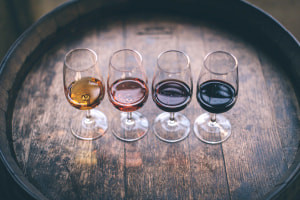This course in the fundamentals of wine production and storage is designed to give you a solid foundation required to understand the manufacturing process and appropriate storage of wine. Areas covered include the structure and the main sections of a grape as the primary raw material used in the production process. Next, the fermentation process is explained and how pasteurisation is used to increase the shelf life of manufactured food. The course outlines the different vocabulary used in the wine and hospitality industry and the wine naming conventions usually derived from the name of the grape variety or the region in which the wine is manufactured. Then, the world's geographic regions are outlined, where the best climatic conditions are obtained to grow grapes on an industrial scale and produce the best flavours. You will also learn how to store wine and the most appropriate temperature to serve it.
Wine is an alcoholic drink generally made from fermented grapes. Different varieties of grapes and strains of yeasts are the key factors in differentiating the styles of wine. Many countries enact legal terms intended to define qualities and styles of wine. These typically restrict the geographical origin and allowable varieties of grapes and other characteristics of wine production. Wines are not only made from grapes. A small percentage are fermented from other products, including rice and fruits such as pomegranate, plum, cherry, and elderberry. Wine has been manufactured for thousands of years. The earliest proof of wine production is from ancient China around 7000 BC and Georgia around 6000 BC. New world wine has some links to alcoholic beverages made by the indigenous peoples of the Americas as a result of improvements in viticulture techniques. Europe grew to encompass three of the largest wine-producing regions. The five countries with the largest wine-producing regions are the United States, Italy, Spain, France and China.
Wine is a popular beverage that accompanies and enriches many cuisines, from traditional and straightforward stews to the most contemporary and complex cuisines. Wine is often served with dinner or sweet desserts. At a restaurant, the wine waiter or sommelier may advise clients to make good food-wine pairings. People dining with family at home may use wine guides to help make good combinations of food-wine pairings. Wine can also be drunk without the accompaniment of a meal in wine bars or with an assortment of cheeses at a wine or cheese party. Wines are also used as a theme for setting up various events such as carnivals around the world. For example, the city of Kuopio in Finland is known for its yearly Kuopio Wine festival. Wine has also long played a significant role in religious ceremonies. Red wine was used to resemble blood by the ancient Egyptians and was used by the Romans in their Bacchanalia. Judaism also incorporates the use of red wine in the Kiddush and the Eucharist by Christians. Master the wine basics and excite your taste buds by enrolling in this course today!
What You Will Learn In This Free Course
View All Learning Outcomes View Less All Alison courses are free to enrol, study, and complete. To successfully complete this Certificate course and become an Alison Graduate, you need to achieve 80% or higher in each course assessment.
Once you have completed this Certificate course, you have the option to acquire an official Certificate, which is a great way to share your achievement with the world.
Your Alison certificate is:
- Ideal for sharing with potential employers.
- Great for your CV, professional social media profiles, and job applications.
- An indication of your commitment to continuously learn, upskill, and achieve high results.
- An incentive for you to continue empowering yourself through lifelong learning.
Alison offers 2 types of Certificate for completed Certificate courses:
- Digital Certificate: a downloadable Certificate in PDF format immediately available to you when you complete your purchase.
- Physical Certificate: a physical version of your officially branded and security-marked Certificate
All Certificate are available to purchase through the Alison Shop. For more information on purchasing Alison Certificate, please visit our FAQs. If you decide not to purchase your Alison Certificate, you can still demonstrate your achievement by sharing your Learner Record or Learner Achievement Verification, both of which are accessible from your Account Settings.











 Avg. Hours
Avg. Hours  Contains Video
Contains Video  CPD Accredited
CPD Accredited 


 Total XP:
Total XP: 
 Knowledge & Skills You Will Learn
Knowledge & Skills You Will Learn 







